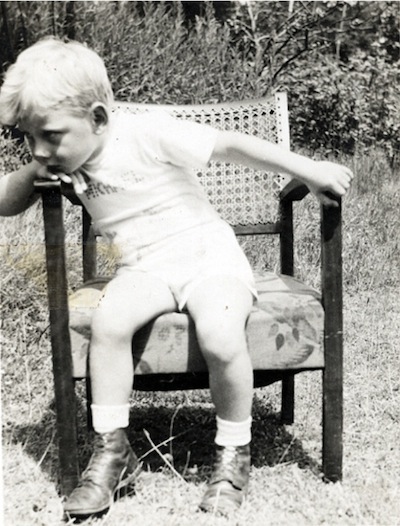By Heathcote Williams
His approach to life and politics was fueled by emotion rather than the twisted logic of compliance. Finding himself born into an era when life on earth seemed daily–and increasingly–under threat, Mike Lesser’s logic was visceral. Other Angry Young Men long ago may have mellowed and somehow come to terms with a culture slouching towards self-destruction. He never did.
Mike Lesser has died aged 71. He had a fiery baptism into the counterculture when arrested at the age of 16 along with the nonagenarian philosopher Bertrand Russell and others at a big sit-down protest in Whitehall mounted by the Committee of 100, the Ban the Bomb movement’s civil disobedience wing.The Nobel Prize winner and master logician was driven to Brixton Prison; the renegade schoolboy found himself banged up in Wormwood Scrubs. Mike’s distinction was that he was not just the youngest of the Committee of 100, but also, even more remarkably perhaps, the youngest of the ‘Spies for Peace.’ The Spies’ anonymous exposure of the existence of a top secret national network of underground bunkers to keep a privileged élite of political, military and civil administrators safe in the event of nuclear attack, while everybody above ground roasted, was the one of the biggest embarrassments suffered by the UK government in the post-War period.
Thousands of copies of an amateurish-looking pamphlet titled ‘Danger! Official Secret RSG-6’ were sent to the national media, and distributed along the route of the 1963 Aldermaston March. A grainy photograph of ‘Regional Seat of Government 6,’ a bunker near Reading, featured on the cover, and was duly surrounded and scrambled over by a multitude of Aldermaston marchers.The pamphlet’s contents were anything but amateurish: it listed phone numbers of RSGs up and down the country and it named names. The Cabinet and security services were thrown into consternation. Though baseless, as it turned out, Soviet involvement was suspected. All the dogs were out.
The self-styled Spies included young married couples with children, and the former washboard-player of a nationally known skiffle group. Yet the intelligence services, in all the years that followed, never succeeding in pinning charges on anyone.
Mike Lesser slipped away to Denmark. The experience had an inevitably further radicalising effect. Nor was he ever brought to book for rumoured involvement in the springing of spy George Blake from Mike’s alma mater, Wormwood Scrubs.
While Mike was constitutionally subversive, he had a devilish luck and a nimble ‘Scarlet Pimpernel’ survival instinct due to a settled reluctance to spend any further time in jail.He was short in height, blond haired, prone to volcanic displays of temper, and perpetually smoking industrial quantities of recreational drugs. Mike was easily crossed but was an obsessively loyal friend; magnanimous, cantankerous, fearless and ingeniously resourceful. His friends would say of him that he was someone to ‘go into the trenches with.’
Mike was an extraordinarily protean mixture. An ultra-contrarian. One minute he was opening up a hippie badge shop, The Badge Boutique, in Whitfield Street whose imprint The Pirate Press, managed by Terry Chandler, was noted for churning out thousands of fake dollars which, instead of reading ‘In God We Trust,’ read, ‘Is This Worth All the Murder & Slaughter in Vietnam?’.
The next minute Mike had become a dealer in gold bullion at which point he was almost always to be seen in a dapper suit – save for a notorious occasion at the psychedelic event known as ‘The 14 Hour Technicolour Dream’ at Alexandra Palace when he was naked.This was a fund-raising benefit for The International Times (IT), in April 1967, where Mike’s behavior prompted the shock-horror tabloid headline: “RAVING LONDON”, followed by, “London isn’t swinging anymore, it’s raving. At least when scenes like this can happen in the name of “freedom of expression”.
Mike had “stripped naked and rolled sensually about in coloured edible jelly”.
Likewise, whilst he came from an ardently Zionist background (he’d grown up with friends of his father’s sitting around the kitchen table discussing methods of blowing up the House of Commons because of their belief that the British Government was taking a misguidedly pro-Arab line), Mike was a vehement critic of Israel, and, as an anarchist, set his teeth against its very existence as a State.
Mike survived as a rentier, but, contradictory as this might seem, was nonetheless fiercely anti-capitalist; an anarcho-communist who, together with Robert Tascher, produced a special issue of International Times from Paris in May, 1968 at the time of ‘les évènements.’Mike had an impassioned relationship with IT, keeping it afloat with his own funds, editing it on occasion with the novelist Max Handley, Lyn Solomon and Chris Sanders, and then with Sid Rawle, the self-styled ‘King of the Hippies’, and it was Mike who ensured that there’d be a comprehensive online IT archive by buying up every available back number, scanning them in and creating a searchable database.
Equally important, it was Mike who was instrumental in reviving IT as an online presence with a new edition published weekly. Every Thursday sees new items posted. No money changes hands. There is no budget to speak of. Nonetheless IT manages to attract postings from all over the world: from ‘Occupy’ in New York and San Francisco to anarchist enclaves in Greece, reflecting international times.
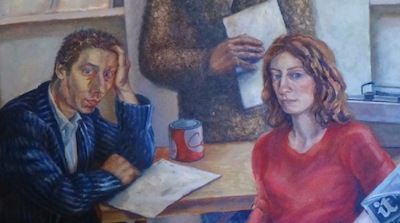
Detail of an IT editorial meeting featuring Mike Lesserand Lyn Solomon, from a painting by Nicola Lane, 1978-9.
Thanks to Mike’s perseverance IT has had over a million views since its online incarnation and the fact that IT achieves a hit rate of some ten thousand views a week shows that its libertarian, anarchist vision is undimmed.
It was a vision that for Mike had had its roots in his collaboration with Charles Radcliffe, and Chris Gray on issues of the proto-Situationist magazine, ‘Heatwave’ and also in his relationship with Terry Chandler, Mike’s enduring hero, someone he’d always refer to in awed tones.
Chandler was one of the so-called ‘Eskimos’ who’d attempted to board the Polaris submarine Patrick Henry on the Clyde from their kayaks in 1961, and it was Chandler who had instigated the Pirate Press dollars prank which resulted in an Old Bailey trial for forgery, prompted it was believed, by pressure from the US government and at which a trench-coated CIA man gave evidence.
Chandler was regarded at the time by Sgt Roy Cremer, Special Branch’s self-described ‘anarchist & Committee of 100 specialist’, as his key adversary. (This was, of course, before the arrival of the Angry Brigade and the Provisional IRA.)
Mike was keen on calling IT the “newspaper of resistance” to which poets, polemicists, artists, musicians and video vigilantes were, and of course still are, invited to enjoy ready and often undiscriminating access.Some of Mike’s North Kensington graffiti were featured in the recent republication of the Roger Perry book The Writing on the Wall, edited by George Stewart-Lockhart, notably Mike’s own slogan, ‘Freedom is a Career’, as was his collaborative contribution, as an invigorating member of the ‘Anarchist Spray Ballet’, to the painting of a lengthy slogan on one of the walls of Buckingham Palace that runs alongside Constitution Hill. Four Ministry of Works vans were employed to erase it (unsuccessfully) the next day.
In dramatic contrast to these mercurial and often wayward aspects of his character, Mike was also a scientist and mathematician. Mike’s father Jack Lesser, a captain of industry, had run a large plastics factory called Crystalate at Tonbridge in Kent and this was not only to inform Mike’s business acumen but, thanks to his work at Crystalate (developing prosthetic limbs for thalidomide children and working on injection molding), Mike became interested in developing computer programs for industrial processes and in this was greatly encouraged by his father.
Mike once claimed that his father “raised him from birth to mechanise all society’s waged labouring roles” and with his gradual expertise over robotic engineering (a process now referred to as “fully automated luxury communism”), Mike’s programming skills, together with his mathematical work on parallel systems and on automation, came to be in considerable demand beyond the confines of Crystalate.
Mike’s pioneering efforts are acknowledged as having speeded up the development of 3-D graphics, now commonplace on computers and mobile phones, and his original work on artificial intelligence would inform fault-tolerant learning systems.
Unsurprisingly, thanks to this other string to his anarchist bow, Mike’s genius was head hunted. He worked on occasion for the Rutherford Appleton Lab, and in 1989-90 on supercomputers at NASA’s Goddard Jet Propulsion Lab in Washington, D.C. in association with his friend Jack Corliss who discovered life in deep ocean hydrothermal vents. For fourteen years he was assistant to the Directing Professor, P. Allen, at the IERC, International Ecotechnology Research Centre at Cranfield University, and he co-authored with Professor Allen, Evolutionary Theories of Economic Change (Harwood Academic Publishers, 1991). One of his Cranfield projects was to create a complex system programme that successfully located where the cod shoals were hiding in the North Atlantic. Together with Prof Allen and Andy Wuensche, Mike also wrote The Global Dynamics Of Cellular Automata (Santa Fe Institute, 1992). The book, which appeared in the Santa Fe Institute’s series “Studies in the Sciences of Complexity,” was dedicated by Mike “To the Memory and achievements and the tragic end of Alan Turing.”In his foreword Chris Langton compared their ideas and their novelty to Henri Poincaré’s in continuous dynamical systems. The book became a classic in the field of complex systems, and continues to have a profound impact, having revealed for the first time “basins of attraction” of discrete dynamical systems, with deep significance in many areas from physics to biology, in particular ideas of order, complexity, chaos and self-organization. The book’s direct offshoots provide a new paradigm in understanding memory in neural networks, and in genetic regulatory network dynamics.
As regards Mike’s impact in the field, his associate Dan Parmentier makes the dramatic claim that every iPhone that has 3-D graphics as a feature owes something to Mike Lesser’s cybernetic spade-work pursued over some forty years.Shortly before his death Mike, together with Keith Rodway of the Trash Cannes Film Festival, was furthering plans for an online International Times Film Festival and for IT’s projected 50th anniversary at the ICA in 2016.
His approach to life and politics was fueled by emotion rather than the twisted logic of compliance. Finding himself born into an era when life on earth seemed daily–and increasingly–under threat, Mike Lesser’s logic was visceral. Other Angry Young Men long ago may have mellowed and somehow come to terms with a culture slouching towards self-destruction. Mike Lesser never did.
And Mike’s work remains significant. To those who query whether the ‘Spies for Peace’ publication made a useful difference: in historiographical terms alone it did so sufficiently to feature in the exhibition at the National Archive that accompanied publication of Peter Hennessy’s The Secret State (2002). Mike’s role was to expose these Cold War secret bunkers that, according to Hennessy, “encapsulated the distrust, fear and feelings of a generation”.Despite the Freedom of Information Act, the modern British state is as secretive as ever it was and it encroaches even more, but Mike and the rest of the ‘Spies for Peace’ showed that resistance could be fertile.
Predictably the leadership of CND, the CP, and Labour Party, opposed the spies as not being quite respectable. “Adventurists” was the ritual accusation leveled at them by desk-bound ‘activists’. Nonetheless, while they may have proved shy of exposing these RSGs, or Regional Seats of Government, because of the possible consequences, (i.e. lengthy terms of imprisonment for this breach of an official secret) the RSG acronym was quickly made to stand for: “Resistance Shall Grow” by movement wits — the dogs barked but the caravan moved on.
Terry Chandler, once listed by the authorities as ‘Most Wanted’, also remembers Mike’s involvement at the same time in VND which “started the whole pirate radio scene — Radio Caroline etc.” “He [Mike] was one of the secret group which organized VND, the Voice of Nuclear Disarmament, an illegal pirate radio station which transmitted in London in the early sixties and came online when the BBCTV closed (as it always used to) at 11pm. The BBC detector vans made great efforts to locate the ever moving transmitters, but failed to do so.”Chandler further adds that “It might be good to mention: Mike the Plumber. (‘He was really happy working on a building site.’) Mike the cook. Mike the fist fighter. Mike the writer who couldn’t spell; and Mike’s Irish roots. (‘His mother was Irish and he always regarded that as big an influence as his father’s Jewish roots.’)”
In the words of the Waterboys’ song, Mike was the “nearest thing to hip in this shithole and it’s gone”.
With grateful acknowledgements to Richard Adams, Iphgenia Baal, Elena Caldera,Terry Chandler, Boris Ćorović , Nigel Fountain, Eve Grace, Jan Herman, Jonangus Mackay, Nicola Lane, Chris Osland, Claire Palmer, Dan Parmentier, Keith Rodway, George Stewart-Lockhart, Mark Strathern, Robert Tascher, Nicky Victor and Andrew Wuensche. Their help was invaluable in compiling this tribute.
September 28, 1943 – July 1, 2015

![Mike Lesser, 1980 [Photo: Nicky Victor]](http://www.artsjournal.com/herman/wp/wp-content/uploads/2015/07/1-photo-Nicky-Victor-1980-200.jpg)
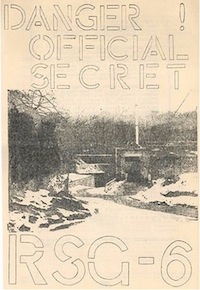
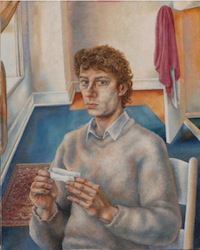
![Mike Lesser, 1967 [Photo: Tony Barnett]](http://www.artsjournal.com/herman/wp/wp-content/uploads/2015/07/4-Photo-Tony-Barnett-1967-200.jpg)
![Photo of Mike Lesser [from the Collection of Pete Stansill]](http://www.artsjournal.com/herman/wp/wp-content/uploads/2015/07/5-Collection-Pete-Stansill-200.jpg)
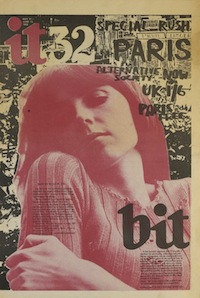
![Mike Lesser [line drawing by Nicola Lane]](http://www.artsjournal.com/herman/wp/wp-content/uploads/2015/07/8-Mike-drawing-by-Nicola-200.jpg)
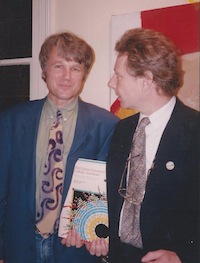
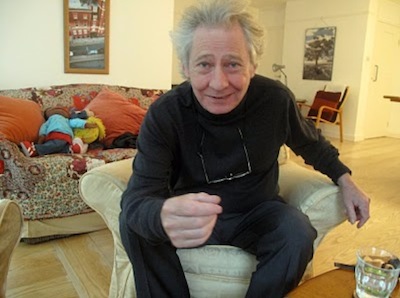
![Mike Lesser outside Wormwood Scrubs (circa 1963) [Photo: John 'Hoppy' Hopkins]](http://www.artsjournal.com/herman/wp/wp-content/uploads/2015/07/11-Mike-outside-Wormwood-Scrubs-400.jpg)
!['Freedom' graffiti by Mike Lesser [Photo: Roger Perry]](http://www.artsjournal.com/herman/wp/wp-content/uploads/2015/07/Freedom-Is-A-Career400.jpg)
